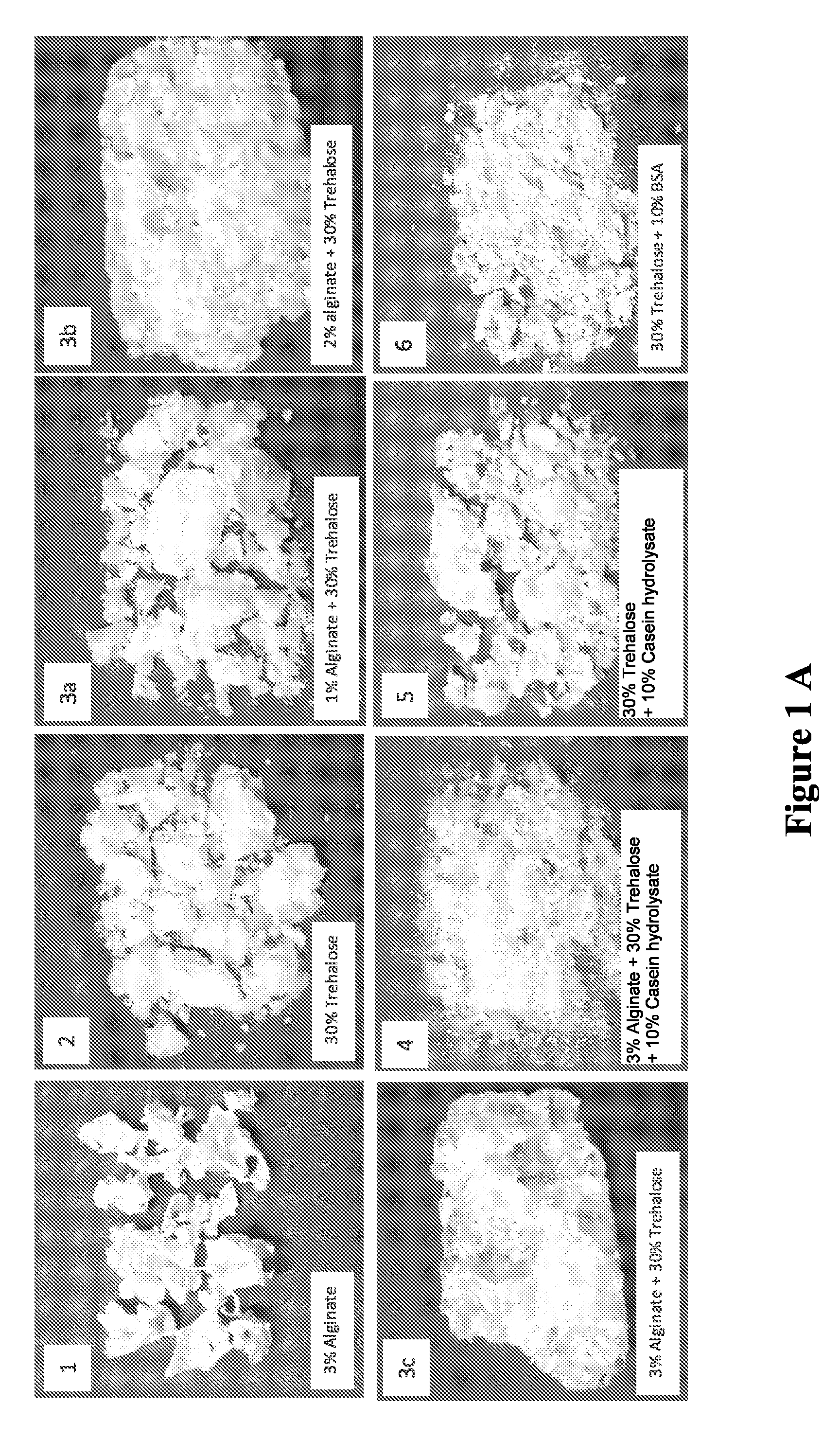Dry glassy composition comprising a bioactive material
a bioactive material and composition technology, applied in the direction of drug compositions, enzymology, herbicides and algicides, etc., can solve the problems of insufficient drying of the material, significant damage to the bioactive material itself, and other methods such as spray drying and desiccation fluidized spray drying and desiccation are generally not suitable, so as to reduce the water activity of the formulation and maximize the stability of the final product
- Summary
- Abstract
- Description
- Claims
- Application Information
AI Technical Summary
Benefits of technology
Problems solved by technology
Method used
Image
Examples
example 1
Preparation of Dry and Stable Probiotic Substance
[0079]Basic Formulation
[0080]75 g of trehalose (Cargill Minneapolis, Minn.) and 22 g of extensively hydrolyzed casein (Marcor, Carlstadt, N.J.) were uniformly mixed with 3 g of sodium alginate (ISP Corp., Wayne, N.J.) in dry form. Fresh concentrate of Lactobacillus acidophilus (100 ml containing at least 10% solids, direct from fermentation harvest) was added in a blender and maintained at 35° C. The dry mix of the gum, sugar and hydrolyzed protein was slowly added to the probiotic culture and mixing was carried out at 35° C. for 10 minutes. The viscous slurry was then transferred to a vessel having a perforated bottom and allowed to drip into a bath containing nitrogen. The beads were then removed from the liquid nitrogen and immediately transferred to drying.
[0081]Drying of the Frozen Beads of the Basic Formulation
[0082]The frozen beads were evenly spread on a tray at a loading capacity of 100 g / sq ft and immediately placed on a she...
example 2
Stable Dry Composition Containing Probiotic Bacteria Lactobacillus rhamnosus LGG
[0083]Lactobacillus rhamnosus LGG (500 g frozen concentrate from a commercial source) was thawed at 37° C. in a jacketed dual planetary mixer (DPM, 1 qt, Ross Engineering, Inc. Savannah, Ga.). Two glass forming agents; trehalose (387 g, Cargill Minneapolis, Minn.) and extensively hydrolyzed casein (83 g, Marcor, Carlstadt, N.J.) were homogenously mixed in dry form with two matrix forming agents; sodium alginate (15 g, ISP Corp., Wayne, N.J.) and instant Inulin (25 g, Cargill Minneapolis, Minn.). The dry mix was slowly added to the thawed probiotic bacteria and mixing was carried out at 40 RPM and 37° C. for 10 minutes. The viscosity of the slurry was adjusted to 12,000 Cp by the addition of 50-200 ml of water. The slurry was then transferred to a vessel having a perforated bottom and allowed to drip into a vessel containing liquid nitrogen. The beads were then removed from the liquid nitrogen, placed in ...
example 3
[0087]Trehalose (752 g, Cargill Minneapolis, Minn.), extensively hydrolyzed Pea protein (167 g, Marcor, Carlstadt, N.J.), sodium alginate (30 g, ISP Corp., Wayne, N.J.) and instant Inulin 50 g, Cargill Minneapolis, Minn.) were homogenously blended in dry form. The dry mix was slowly added to 1000 ml hot de-ionized water at 80° C. in a jacketed dual planetary mixer (DPM, 1 qt, Ross Engineering, Inc. Savannah, Ga.) and mixing was carried out at 40 RPM for 10 minutes. The mixture temperature was reduced to 37° C.° C. and 100 g dry powder of Lactobacillus rhamnosus LGG obtained from a commercial source was slowly added and mixing continued for 20 minutes. The slurry was then extruded through a 2 mm orifice needle into a bath containing liquid nitrogen. The / strings / beads were then removed from the liquid nitrogen placed in sealed aluminum foiled bag and stored in a deep freezer at −80° C. for several weeks. For drying, the frozen strings / beads were evenly spread on trays at a loading ca...
PUM
| Property | Measurement | Unit |
|---|---|---|
| Temperature | aaaaa | aaaaa |
| Temperature | aaaaa | aaaaa |
| Percent by mass | aaaaa | aaaaa |
Abstract
Description
Claims
Application Information
 Login to View More
Login to View More - R&D
- Intellectual Property
- Life Sciences
- Materials
- Tech Scout
- Unparalleled Data Quality
- Higher Quality Content
- 60% Fewer Hallucinations
Browse by: Latest US Patents, China's latest patents, Technical Efficacy Thesaurus, Application Domain, Technology Topic, Popular Technical Reports.
© 2025 PatSnap. All rights reserved.Legal|Privacy policy|Modern Slavery Act Transparency Statement|Sitemap|About US| Contact US: help@patsnap.com



